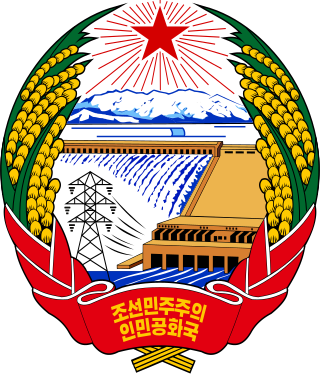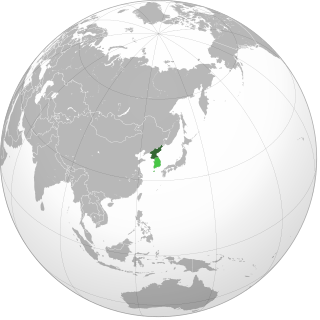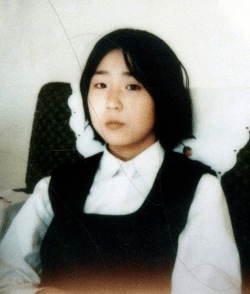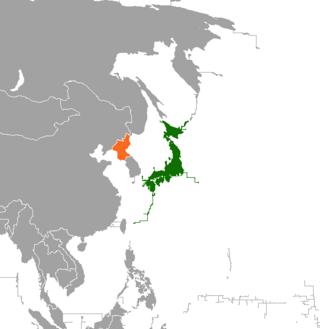Contents
| |||||
| Centuries: | |||||
|---|---|---|---|---|---|
| Decades: | |||||
| See also: | Other events of 2006 Years in North Korea Timeline of Korean history 2006 in South Korea | ||||
Events from the year 2006 in North Korea.
| |||||
| Centuries: | |||||
|---|---|---|---|---|---|
| Decades: | |||||
| See also: | Other events of 2006 Years in North Korea Timeline of Korean history 2006 in South Korea | ||||
Events from the year 2006 in North Korea.

North Korea, officially the Democratic People's Republic of Korea (DPRK), is a country in East Asia. It constitutes the northern half of the Korean Peninsula and borders China and Russia to the north at the Yalu (Amnok) and Tumen rivers, and South Korea to the south at the Korean Demilitarized Zone. The country's western border is formed by the Yellow Sea, while its eastern border is defined by the Sea of Japan. North Korea, like its southern counterpart, claims to be the sole legitimate government of the entire peninsula and adjacent islands. Pyongyang is the capital and largest city.

The Korean People's Army encompasses the combined military forces of North Korea and the armed wing of the Workers' Party of Korea (WPK). The KPA consists of five branches: the Ground Force, the Naval Force, the Air Force, Strategic Force, and the Special Operation Force. It is commanded by the WPK Central Military Commission, which is chaired by the WPK general secretary, and the president of the State Affairs; both posts are currently headed by Kim Jong Un.

North Korea has diplomatic relations with 160 states. The country's foreign relations have been dominated by its conflict with South Korea and its historical ties to the Soviet Union. Both the government of North Korea and the government of South Korea claim to be the sole legitimate government of the whole of Korea. The de facto end of the Korean War left North Korea in a military confrontation with South Korea along the Korean Demilitarized Zone.

North Korea has a military nuclear weapons program and, as of 2024, is estimated to have an arsenal of approximately 50 nuclear weapons and sufficient production of fissile material for six to seven nuclear weapons per year. North Korea has also stockpiled a significant quantity of chemical and biological weapons. In 2003, North Korea withdrew from the Treaty on the Non-Proliferation of Nuclear Weapons (NPT). Since 2006, the country has conducted six nuclear tests at increasing levels of expertise, prompting the imposition of sanctions.

Relations between North Korea and the United States have been historically hostile. The two countries have no formal diplomatic relations. Instead, they have adopted an indirect diplomatic arrangement using neutral intermediaries. The Swedish Embassy in Pyongyang is the US protecting power and provides limited consular services to U.S. citizens. North Korea, officially the Democratic People's Republic of Korea (DPRK), does not have an embassy in Washington, DC, but is represented in the United States through its mission to the United Nations in New York City which serves as North Korea's de facto embassy.

The Korean conflict is an ongoing conflict based on the division of Korea between North Korea and South Korea, both of which claim to be the sole legitimate government of all of Korea. During the Cold War, North Korea was backed by the Soviet Union, China, and other allies, while South Korea was backed by the United States, United Kingdom, and other Western allies.

USS Philippine Sea was one of 24 Essex-class aircraft carriers of the United States Navy, and the first ship to be named for the Battle of the Philippine Sea. She was launched on 5 September 1945, after the end of World War II, and sponsored by the wife of the Governor of Kentucky.

The Chevrolet Aveo (T200) is the first generation of the Chevrolet Aveo, a subcompact automobile nameplate from the Chevrolet division of the American manufacturer General Motors. The T200 was launched in 2002, developed by the initially-independent South Korean manufacturer Daewoo, later GM Korea. It was originally marketed as the Daewoo Kalos and prominently marketed with the Chevrolet brand as the Aveo. The model received the T200 internal codes during the car's development. The T250 code was designated for the model's major facelift.

Terminal High Altitude Area Defense (THAAD), formerly Theater High Altitude Area Defense, is an American anti-ballistic missile defense system designed to intercept and destroy short, medium, and intermediate-range ballistic missiles in their terminal phase. The THAAD interceptor carries no warhead, instead relying on its kinetic energy of impact to destroy the incoming missile. THAAD was developed after the experience of Iraq's Scud missile attacks during the Gulf War in 1991.
The six-party talks aimed to find a peaceful resolution to the security concerns as a result of the North Korean nuclear weapons program. There was a series of meetings with six participating states in Beijing:

The Donghae Bukbu Line is a former railway line that connected the present-day city of Anbyon in Kangwon Province, North Korea, with Yangyang, Gangwon Province, South Korea. Since the division of Korea it has only carried trains for a brief period during 2007/8. The line originally connected to the Gyeongwon Line running from Gyeongseong to Wonsan.

Megumi Yokota is a Japanese citizen who was abducted by a North Korean agent in 1977 when she was a thirteen-year-old junior high school student. She was one of at least seventeen Japanese citizens kidnapped by North Korea in the late 1970s and early 1980s. The North Korean government has admitted to kidnapping Yokota, but has said that she died in captivity. Yokota's parents and others in Japan have publicly expressed the belief that she is still alive in North Korea and have waged a public campaign seeking her return to Japan.

Two rounds of North Korean missile tests were conducted on July 5, 2006. The Democratic People's Republic of Korea reportedly fired at least seven separate missiles. These included one long-range Taepodong-2 missile and short-range Scud derived missiles including the enlarged Nodong missile. The Taepodong-2 was estimated by United States intelligence agencies as having a potential range reaching as far as Alaska, although this missile failed after about 42 seconds of flight.

The 2006 North Korean nuclear test was the detonation of a nuclear device conducted by North Korea on October 9, 2006.

This chronology of the North Korean nuclear program has its roots in the 1950s and begins in earnest in 1989 with the end of the Cold War and the collapse of the Soviet Union, the main economic ally of North Korea. The chronology mainly addresses the conflict between the United States and North Korea, while including the influences of the other members of the six-party talks: China, Russia, South Korea, and Japan.

Japan–North Korea relations refers to international relations between Japan and North Korea. Relations between Japan and North Korea have never been formally established, but there have been diplomatic talks between the two governments to discuss the issue of kidnapped Japanese citizens and North Korea's nuclear program. Relations between the two countries are severely strained and marked by tension and hostility. According to a 2014 BBC World Service poll, 91% of Japanese people view North Korea's influence negatively, with just 1% expressing a positive view; the most negative perception of North Korea in the world.

Brazil–North Korea relations are the current and historical bilateral relations between Brazil and North Korea. Brazil has an embassy in Pyongyang and North Korea has an embassy in Brasília.

The Type 58 is an assault rifle made in North Korea derived from the Soviet AK-47 designed by Mikhail Kalashnikov. This was the first weapon made in North Korea alongside the PPSh-41, made under license as the Type 49. It was made in Factory 61 and 65 in Chongjin.
Events from the year 2015 in North Korea. The year marks the 70th anniversary of the founding of the Workers' Party of Korea. The year was celebrated as the year of DPRK-Russia friendship.